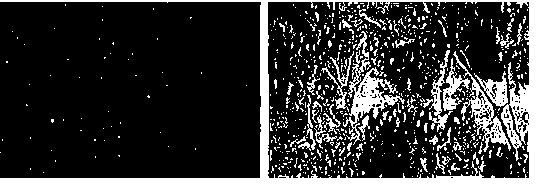Carrier system and method for inputting nanoparticles into cell
A nanoparticle and carrier system technology, applied in the field of nanomaterials, can solve problems such as toxicity, avoid cell membrane rupture, and improve aggregation efficiency.
- Summary
- Abstract
- Description
- Claims
- Application Information
AI Technical Summary
Problems solved by technology
Method used
Image
Examples
Embodiment 1
[0044] A carrier system for introducing nanoparticles into cells, characterized in that the carrier system is lipid microbubbles, which are prepared by the following steps:
[0045] (1) Evenly mix egg yolk lecithin EPC in chloroform solvent to prepare a mixed solution;
[0046] (2) Place the mixed solution in a rotary evaporating drier at 30°C to evaporate to dryness, and then place it in a desiccator to remove trace solvents to obtain a dry lipid film;
[0047] (3) Add the dried lipid film to phosphate buffer, place in a shaker and vibrate for 30 min-2 h to hydrate the lipid film;
[0048] (4) Place the hydrated lipid film in an ultrasonic cavitation instrument, and conduct ultrasonic cavitation for 10-60 min while passing nitrogen gas into the hydrated lipid film. The ultrasonic cavitation power is 80-180 W. Obtain microbubble solution;
[0049] (5) Wash the microbubble solution with phosphate buffer, then add avidin, and shake at 0°C for 30 min-2 h; after washing with pho...
Embodiment 2
[0055] A carrier system for introducing nanoparticles into cells, characterized in that the carrier system is lipid microbubbles, which are prepared by the following steps:
[0056] (1) Uniformly mix lecithin PC and soybean lecithin in chloroform solvent to prepare a mixed solution;
[0057] (2) Place the mixed solution in a rotary evaporating drier at 30°C to evaporate to dryness, and then place it in a desiccator to remove trace solvents to obtain a dry lipid film;
[0058] (3) Add the dried lipid film to phosphate buffer, place in a shaker and vibrate for 30 min-2 h to hydrate the lipid film;
[0059] (4) Place the hydrated lipid film in an ultrasonic cavitation instrument, and conduct ultrasonic cavitation for 10-60 min while passing argon gas into the hydrated lipid film, and the ultrasonic cavitation power is 80-180 W , to obtain microbubble solution;
[0060] (5) Wash the microbubble solution with phosphate buffer, then add avidin, shake at 0°C for 30 min-2 h; after w...
Embodiment 3
[0066] A carrier system for introducing nanoparticles into cells, characterized in that the carrier system is lipid microbubbles, which are prepared by the following steps:
[0067] (1) Uniformly mix lecithin (PC), pegylated distearoylphosphatidylcholine (DSPE-PEG), and cholesterol in chloroform solvent to prepare a mixture;
[0068] (2) Place the mixed solution in a rotary evaporating drier at 30°C to evaporate to dryness, and then place it in a desiccator to remove trace solvents to obtain a dry lipid film;
[0069] (3) Add the dried lipid film to phosphate buffer, place in a shaker and vibrate for 30 min-2 h to hydrate the lipid film;
[0070] (4) Place the hydrated lipid film in an ultrasonic cavitation instrument, and conduct ultrasonic cavitation for 10-60 min while passing oxygen into the hydrated lipid film, and the ultrasonic cavitation power is 80-180 W. Obtain microbubble solution;
[0071] (5) Wash the microbubble solution with phosphate buffer, then add avidin, ...
PUM
| Property | Measurement | Unit |
|---|---|---|
| particle diameter | aaaaa | aaaaa |
Abstract
Description
Claims
Application Information
 Login to View More
Login to View More - R&D
- Intellectual Property
- Life Sciences
- Materials
- Tech Scout
- Unparalleled Data Quality
- Higher Quality Content
- 60% Fewer Hallucinations
Browse by: Latest US Patents, China's latest patents, Technical Efficacy Thesaurus, Application Domain, Technology Topic, Popular Technical Reports.
© 2025 PatSnap. All rights reserved.Legal|Privacy policy|Modern Slavery Act Transparency Statement|Sitemap|About US| Contact US: help@patsnap.com


